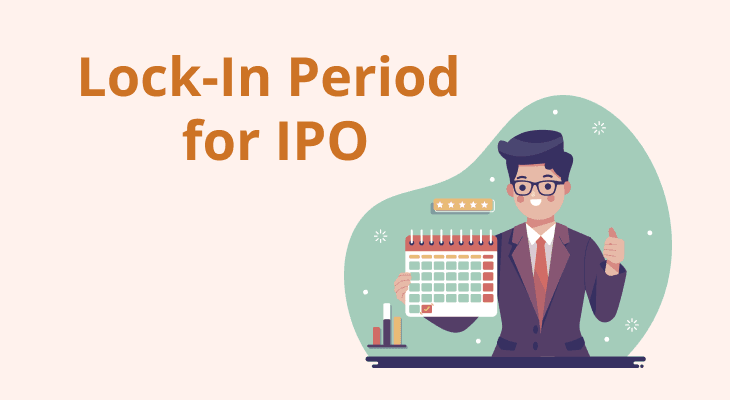
Lock-In Period for IPO: Definition, Types & How It Works
Investing in an Initial Public Offering (IPO) comes with various aspects to consider, and one of the most crucial is the lock-in period. When a company goes public through an IPO, its existing shareholders — such as promoters, employees, and pre-IPO investors — may have a contractual restriction on selling their shares for a specific period. This restriction is known as the IPO lock-in period. The lock-in period prevents excessive stock dumping immediately after listing, ensuring market stability. In this article, we will explore the lock-in period for IPO in detail, including its types, workings, and implications for investors.
What Is a Lock-In Period for an IPO?
A lock-in period for an IPO refers to the timeframe during which company insiders, promoters, institutional investors, and sometimes retail investors are prohibited from selling their shares. This restriction is designed to prevent an immediate sell-off, which could destabilise the stock price and impact investor confidence.
The lock-in period typically lasts for several months, but the exact duration varies depending on regulatory requirements, market conditions, and company policies. In India, the Securities and Exchange Board of India (SEBI) mandates different lock-in periods for various categories of investors.
Why Does a Lock-in Period Exist?
The primary purpose of an IPO lock-in period is to create stability in the newly listed stock by ensuring that significant shareholders do not offload their holdings immediately. Here’s why it matters:
- Prevents Market Manipulation – If insiders sell a large portion of their holdings right after the IPO, the stock price could fall sharply, hurting retail investors.
- Encourages Long-Term Investment – It reassures new investors that major stakeholders have confidence in the company’s future performance.
- Reduces Volatility – It minimises extreme price fluctuations that could otherwise result from bulk share sales.
- Enhances Investor Trust – A well-defined lock-in period signals that insiders are committed to the company’s growth.
Types of Lock-In Periods in IPOs
There are different types of lock-in periods applicable in an IPO, depending on the investor category. The key types include:
1. Promoter Lock-In Period
Promoters, or company founders and early investors, are required to retain a certain percentage of their holdings for a longer duration. In India, SEBI mandates that post-IPO, at least 20% of the promoter's holdings must remain locked in for 18 months.
2. Pre-IPO Shareholder Lock-In
Investors who bought shares before the IPO (such as venture capitalists and private equity firms) often have a lock-in period of 6 months to 1 year post-listing. This restriction prevents large-scale unloading of shares that could disrupt market stability.
3. Anchor Investor Lock-In
Anchor investors, typically institutional investors like mutual funds and pension funds, participate in the IPO before it opens to the general public. Their shares are usually locked in for 90 days for 50% of the shares and 30 days for the remaining 50%, to prevent early profit booking and maintain investor confidence.
4. Employee Lock-In Period (ESOP Holders)
Employees who receive shares under an Employee Stock Option Plan (ESOP) may have to hold them for a set duration after the IPO. This ensures alignment between employees’ interests and the company’s long-term growth.
5. Retail Investor Lock-In (Special Cases)
While retail investors generally do not have mandatory lock-in periods, in specific cases (such as discounted IPO allotments), there may be restrictions on selling shares within a few months of listing.
How a Lock-In Period Works
Once an IPO is launched and shares begin trading on the stock exchange, stakeholders, subject to a lock-in period, cannot sell their allotted shares until the restriction ends. Here’s a step-by-step breakdown:
- Before the IPO – Promoters, pre-IPO investors, and institutional investors hold a significant portion of shares. The company finalises lock-in agreements to prevent immediate selling.
- After Listing – The stock begins trading, but certain stakeholders must adhere to lock-in restrictions. Retail investors monitor the lock-in expiry date as it may impact stock price movements.
- Lock-In Expiry – Once the period ends, these shareholders are free to sell their holdings in the open market. If the company performs well, many investors may retain their shares instead of selling.
- Market Impact – A large volume of shares becoming available for sale can influence stock prices significantly.
Impact of Lock-In Period on Stock Prices
The expiration of an IPO lock-in period can have a notable impact on the stock price, depending on market conditions and investor sentiment:
1. Potential Selling Pressure
When the lock-in period ends, insiders and early investors may sell shares to realise profits. If a large number of shares flood the market, prices may decline temporarily.
2. Stock Volatility
Lock-in expiration can trigger heightened volatility as traders react to increased supply and shifting investor sentiment.
3. Investor Perception
If key stakeholders continue to hold their shares even after the lock-in period, it signals confidence in the company’s future, which can drive positive investor sentiment. If insiders sell in large quantities, retail investors may perceive it as a lack of confidence in the company’s future.
4. Trading Volume Surge
As locked-in shares become available for trading, liquidity in the stock increases, attracting new buyers and traders.
5. Strategic Selling by Insiders
Experienced investors may offload shares gradually instead of selling all at once to avoid price crashes and maximise returns.
Conclusion
The lock-in period for an IPO is a crucial aspect that impacts stock stability, investor sentiment, and long-term market performance. While it prevents excessive volatility and fosters confidence, its expiry can influence stock prices significantly. Understanding how lock-in periods work helps investors anticipate potential price movements and make informed decisions. While lock-in expirations can lead to short-term volatility, long-term you should assess the company’s fundamentals rather than reacting solely to price fluctuations. By considering factors such as market conditions, insider selling trends, and company growth prospects, you can better navigate IPO investments and maximize your returns.
FAQ
What is an IPO lock-in period?
An IPO lock-in period is a restriction that prevents certain shareholders — such as promoters, pre-IPO investors, and institutional buyers — from selling their shares for a fixed duration after the company goes public. This period helps maintain market stability and prevents excessive volatility in the stock price.
Why do companies have a lock-in period after an IPO?
Companies impose lock-in periods to ensure that major shareholders do not sell their holdings immediately, which could lead to a sharp decline in stock prices. It also builds investor confidence by demonstrating that insiders have a long-term commitment to the company’s growth.
How long does an IPO lock-in period last?
The duration varies based on regulatory requirements and company policies. In India, SEBI mandates a lock-in period of 18 months for promoters, 6 months for pre-IPO investors, and 30-90 days for anchor investors. Some companies may impose longer restrictions voluntarily.
Who is affected by an IPO lock-in period?
The lock-in period applies to promoters, early investors (such as venture capital and private equity firms), anchor investors, and sometimes employees who receive shares through stock options. Retail investors are generally not subject to lock-in restrictions unless they receive discounted IPO shares.
What happens when an IPO lock-in period ends?
When the lock-in period expires, previously restricted shareholders are free to sell their shares in the open market. This can lead to increased trading volume and potential price fluctuations, depending on the number of shares being offloaded and overall market sentiment.
How does the lock-in period impact stock prices?
If a large number of insiders sell shares immediately after the lock-in period ends, the stock price may decline due to increased supply. However, if major investors continue holding their shares, it may signal confidence in the company, potentially supporting stock prices.
Can investors predict stock movements based on lock-in expirations?
Yes, investors often monitor upcoming lock-in expirations to anticipate potential selling pressure. Stocks with a high percentage of locked-in shares may see increased volatility when restrictions end. Analyzing insider selling trends and market conditions can help predict price movements.
Are all IPO investors subject to a lock-in period?
No, retail investors who purchase shares through an IPO are usually not subject to a lock-in period. However, institutional investors, pre-IPO shareholders, and promoters typically face restrictions to ensure orderly stock market behavior post-listing.
Do all IPOs have the same lock-in period rules?
No, lock-in period rules vary by country, stock exchange regulations, and company policies. Some companies may impose additional voluntary restrictions to demonstrate insider confidence and attract long-term investors.
How should investors use lock-in period information for investment decisions?
Investors should track lock-in expiration dates to anticipate market movements and assess insider confidence. If key stakeholders retain their shares post-lock-in, it may indicate strong future prospects. However, if large sell-offs occur, it could signal potential risks, requiring further analysis.


